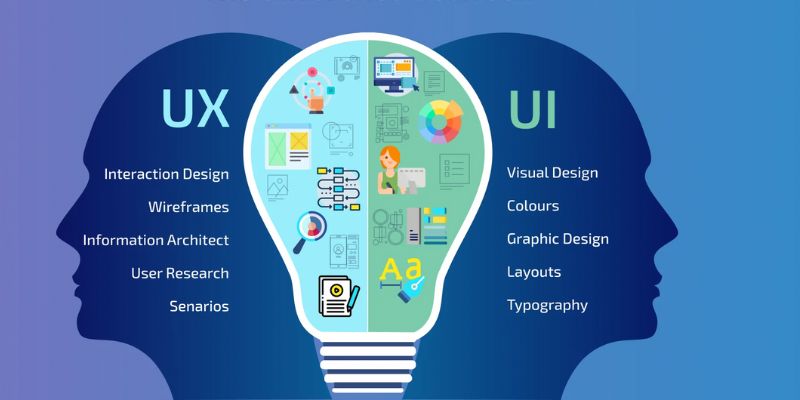
User Interface (UI) refers to screens, buttons, toggles, icons, and other visual elements that you interact with when using a website, app, or electronic device. User Experience (UX) refers to the entire interaction you have with a product, including how you feel about the interaction. While UI can certainly have an impact on UX, the two are distinct, as are the roles that designers play. In this article, we discuss below the skills that are essential for a UI UX Designer
Essential Skills for a UX Designer
A successful UX designer needs both technical and workplace skills to create user-friendly digital experiences. Below are the key skills you should focus on to grow in this field.
Wire framing and prototype
Wireframing and Prototyping are essential frameworks in UI/UX design techniques, which affect how users connect with digital products and services. Wireframes function as the blueprints that form the basic outline for the fundamental structure of a user interface. Prototyping is an interaction and a frequent functional models that bring the essential structure of a user interface to life through responsive and operational representations. It acts as a visual communication tool that helps developers, stakeholders, and designers verify how a product looks and functions before writing any code.
Visual Design and Design Tools
UX and UI designers use visual design software, like Figma, Sketch, Photoshop, and Illustrator, to create the visual elements of a product. Besides proficiency in the tools, you should build your knowledge of visual design best practices for things like typography, color theory, layout, icons, and general design theory.
User Research and Usability Testing
Good design starts with understanding user needs. UX designers use user research to study user behavior and usability testing to check how easy a design is to use. These help refine designs and improve the overall user experience.
Agile Process Understanding
Agile is a flexible project management method used in software development. Understanding how Agile UX Design works will enable you to collaborate more effectively with developers and adapt quickly to project changes.
Information Architecture (IA)
Information architecture focuses on the organization of content. A well-structured IA helps users easily find what they need. Practice by creating sample sitemaps for websites or apps to strengthen this skill.
Basic Application Development
Understanding HTML, CSS, and JavaScript helps UX designers communicate better with developers and make realistic design decisions. This knowledge is especially useful in startups or small teams.
Collaboration, Communication, and Time Management
UX designers often work with multiple teams and must collaborate effectively. Strong communication helps in sharing ideas and gathering feedback. Managing your time and prioritizing tasks ensures smooth project progress. To enhance these skills, consider enrolling in UI UX designer course in Chennai at FITA Academy, where you can gain hands-on experience and professional guidance from industry experts.
Essential Skills for a UI Designer
Becoming a good UI designer needs a mix of basic knowledge, practical skills, and a few key requirements. When you are just starting, focus on learning these main things that will help you build a strong foundation in UI design.
Creativity
Creativity is the heart of UI design. It helps designers solve visual problems and make digital products easy to use and beautiful. A creative UI designer thinks about users’ needs and designs solutions that work for them. Even with rules like brand styles and deadlines, creativity helps you find smart and practical ideas. Exploring, testing, and improving your designs will make you more creative over time.
Basic Graphic Design Skills
Basic graphic design builds the foundation for good user interfaces. It teaches how to use images, fonts, and layouts to communicate visually. Knowing design basics helps you create buttons, icons, and layouts that look attractive and work well. You’ll also learn to use colors, choose fonts, and organize designs that are clear and balanced.
Color Theory
Color theory helps UI designers pick colors that fit the message and emotion of a design. Colors can make users feel calm, excited, or focused. A good color palette keeps the design harmonious. Understanding contrast and accessibility ensures that everyone can read and use your design easily. Practice matching colors and using online tools to check color balance and accessibility.
Typography
Typography is about choosing and using fonts correctly. Readable fonts make your design clean and easy to understand. Use different font sizes and weights to show importance and guide users through information. Keeping text spacing consistent and using simple, clear fonts will make your design professional and user-friendly.
Layout and Composition
Layouts give structure to your design. They organize text, images, and buttons in a way that helps users navigate smoothly. Using grid systems makes your design neat and balanced. Whitespace, or empty space, keeps the layout clean. Always make sure your design works well on both large and small screens.
User-Centered Thinking
Good UI design starts with understanding the user. Research users’ needs and problems before designing. Gather feedback and improve based on real user experience. Building empathy helps you create inclusive and accessible products that everyone can use.
Collaboration and Feedback
UI designers work with developers, managers, and other designers. Sharing ideas, listening to feedback, and refining designs together lead to better results. Being open to feedback helps you learn, grow, and create designs users truly love. If you want to develop these skills hands-on, joining UI UX designer course in Tirupur at FITA Academy is an excellent way to learn from experts and practice with real projects.
In the above article, we discuss about the UI UX and the skills that are essential for a UI UX Designer to create a well-designed product, and also we discuss the design software that UI UX Designers use to design.








